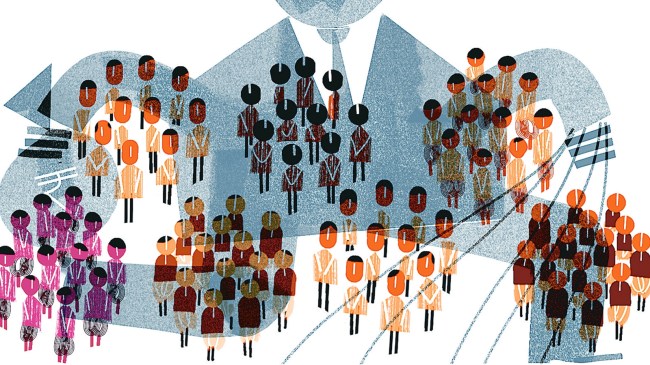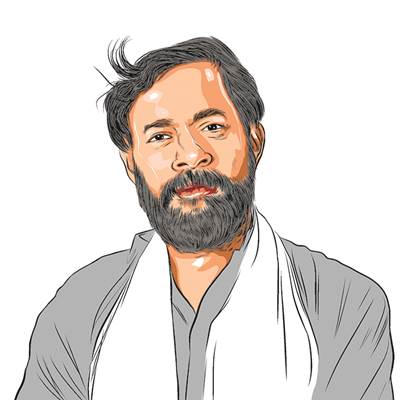Opinion Partha Chatterjee’s new book will change the way we study Indian politics
In ‘For a Just Republic: The People of India and the State’ Chatterjee locates the enduring crisis of the Indian state in the tension between its two layers: the ‘nation-state’ — the formal state apparatus — and the ‘people-nation’, the ground reality that refuses to play by the given script
 ‘Nation-state’ is Chatterjee’s name for the layer that is at once culturally thin but increasingly powerful in terms of its regulatory and coercive capacity. (Illustration by C R Sasikumar)
‘Nation-state’ is Chatterjee’s name for the layer that is at once culturally thin but increasingly powerful in terms of its regulatory and coercive capacity. (Illustration by C R Sasikumar) When was the last time we had a book of such breadth and depth on Indian politics? I asked myself this question as I finished reading Partha Chatterjee’s recent book For a Just Republic: The People of India and the State. My mind raced back to Rajni Kothari’s Politics in India, an iconic book published in 1971 that transformed the way we think about the subject. In a similar way, Chatterjee’s latest offering promises to change the way we study Indian politics since Independence.
This much-awaited book weaves together the many threads that Chatterjee has spun over the last four decades in his multiple avatars. Chatterjee, the historian of ideas, had alerted us to the derivative aspects of our nationalist thought. Chatterjee, the ghost writer for Charvak, had busted the myths the Indian nation likes to tell about itself. Chatterjee, the subaltern studies scholar, had drawn our attention to the mechanisms of governmentality through which the people are controlled by the state. Chatterjee, the anthropologist of power, noted how the people resist these moves by snatching piecemeal concessions from the rulers and how populist rulers in turn respond to regain control. These writings have made Chatterjee into an academic superstar. His arguments have been a staple diet for students of South Asian history and politics.
Yet something was missing from his oeuvre. He owed us an overall account of politics in contemporary India that went beyond the hints and glimpses scattered through his writings, that was not just limited to a critique, that offered us a way forward. This is what Chatterjee does in For a Just Republic. And he does it in a way that only he can. He surveys hundreds of academic monographs spread over fields as diverse as the history of political ideas, political ethnography, regional history, political economy, cultural studies, gender studies and normative political theory, while synthesising all that material into a meta-argument. This is among the many reasons this book is going to stay on the bookshelves for a long time to come.
Besides the breadth and depth, this book shares something substantial with Kothari’s iconic book. Politics in India broke from the lazy assumption that India was following the same track as the West in becoming a developed nation and a liberal democracy. Kothari argued that politics was pivotal to India’s unique modernisation precisely because politics in post-Independence India refused to follow the standard script of western liberal democracies. His was a story of the astonishing deepening of democracy in a traditional society by drawing upon unusual resources like caste and by evolving odd paths like the one-party dominant system. Kothari’s rosy story was to hit the stonewall of the Emergency within five years of its publication. He never released another edition of his own masterpiece.
Chatterjee’s story is not so rosy, but his starting point is also a rejection of the idea that India is following the European trajectory of developing into a modern individualist society, a capitalist economy and a liberal democratic state. Instead, what we have in post-colonial India is a bifurcation of political reality, between the state and the people, the two keywords in the subtitle of the book. On the one hand, we have a formal state apparatus that builds on the legal-administrative frame of the colonial state while claiming the cultural legacy of an ancient civilisation and offering liberal governance to its citizens. This liberal constitutional form of representative government seeks to secure the rule of the dominant capitalist class through coercion and dispensing welfare benefits to its subjects. “Nation-state” is Chatterjee’s name for this layer that is at once culturally thin but increasingly powerful in terms of its regulatory and coercive capacity.
Beneath this formal layer, on the other hand, we have the ground reality that refuses to play by the given script. This reality is anchored differently in different regions of India and varies by its unique caste, class and gender configuration. It shapes very different imaginations of Indian nationhood in different parts of the country — with deep regional memories and only a shallow shared history of the nation. When the fiction of liberal governance hits this ground, it has to reckon with and make exceptions for social groups and communities of poor and disadvantaged people. The logic of rule-based governance has to give way to populist politics with a focus on short-term welfare and inventing an enemy. The dream of capitalist democracy has to confront the reality of a vast population in the informal sector that is redundant for capitalism but essential for political legitimacy. Chatterjee calls this ground reality “people-nation”.
Chatterjee locates the enduring crisis of the Indian state in the tension between these two layers of “nation-state” and “people-nation”, in the “structural failure to adequately tailor the inherited state to fit the cultural form of people-nation”. The crisis is not new. The pluralist advocates of unity-in-diversity shared this failure with the current advocates of Hindu rashtra. What we have today is an uninhibited unfurling of the logic of nation-state, with overt majoritarianism, centralisation of power, a populist ruler presiding over an elected dictatorship and an economy that is split into core zones of capitalist growth versus regions that supply natural resources or cheap labour. But the roots of the crisis go back to the Constituent Assembly, when the imperial state apparatus was accepted as the core of the new nation-state.
The way forward, then, is to institutionalise and deepen the logic of people-nation. This would mean moving towards a just federation that acknowledges all its parts as equal, makes arrangements to counterbalance the dominance of one region and the Hindi language and evolves unique measures for each region to allow for its special requirements. This would also entail an acceptance of coalition as the most appropriate form of political power at the Centre with due acknowledgment of the role of regional parties. At a deeper imaginative plane, it requires acknowledging the newness of India as a body of citizens who share deep history and memory of their region but a shallow shared understanding of the nation.
What, then, is to be done? Chatterjee suggests a threefold shift in deploying our political energies. First, we should shift our attention from the national to the linguistic regions. Accordingly, our focus must shift from all-India campaigns conducted in English and national media to the regional languages. And the focus of economic policies should shift to the mobilisation of small and middle enterprises in the regions. Second, our obsession with law as an instrument for social transformation should give way to social reform that seeks to change the culturally entrenched popular beliefs. And finally, he has a suggestion for “civil society”: Don’t displace or replicate politics, just focus on improving the integrity of public institutions.
You could quarrel with these operational suggestions. You could fault his normative vision. You could confront his core argument about the “nation-state” versus the formulation of “people-nation”. I can already anticipate a series of questions about the relationship between these two: Are these two layers that co-exist, or two models that compete, or two stages that come one after another?
You could ask many more questions. But you cannot now write about Indian politics without reference to For a Just Republic. You cannot ask questions about Indian politics without keeping Chatterjee at the back of your mind. That is the hallmark of a great book. In these uncertain times, it is an opportunity to reckon with our past with an eye to the future.
The writer is member, Swaraj India, and national convenor of Bharat Jodo Abhiyaan





